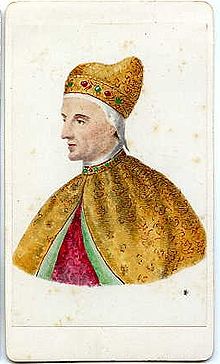Tommaso Mocenigo
Tommaso Mocenigo | |
|---|---|
 | |
| Doge of Venice | |
| In office 1414–1423 | |
| Preceded by | Michele Steno |
| Succeeded by | Francesco Foscari |
| Personal details | |
| Born | 1343 Venice, Republic of Venice |
| Died | 4 April 1423 Venice, Republic of Venice |


Tommaso Mocenigo (1343–1423) was doge (chief magistrate) of the Republic of Venice from 1414 until his death.
Biography[edit]
He commanded the crusading fleet in the expedition to Nicopolis in 1396 and also won battles against the Genoese during the War of Chioggia of 1378–1381.
While he was Venetian ambassador at Cremona, he was elected doge (1414), after previously being a procurator of St Mark's basilica, and he had escaped in secret, fearing that he might be held a prisoner by Gabrino Fondolo, tyrant of that city. He made peace with the Turkish sultan, but, when hostilities broke out afresh, his fleet defeated that of the Turks at the Battle of Gallipoli.
During his reign, the patriarch of Aquileia Louis of Teck formed an anti-Venetian alliance with Emperor Sigismund. Venice, under a double-sided attack, was able to launch an offensive that, in 1419–1420, conquered Udine, Cividale, Feltre, Belluno and most of Friuli from the Aquileian patriarchate. The Cadore also surrendered spontaneously. The ensuing treaty led to a peace with Hungary and the annexation of the patriarchate's lands to the Republic of Venice.
Mocenigo greatly encouraged commerce, reconstructed the ducal palace and commenced the dogal library. He died after a long illness in 1423. He was interred in the Basilica di San Giovanni e Paolo, a traditional burial place of the doges.
See also[edit]
References[edit]
- This article incorporates text from a publication now in the public domain: Chisholm, Hugh, ed. (1911). "Mocenigo". Encyclopædia Britannica. Vol. 18 (11th ed.). Cambridge University Press. p. 637.
